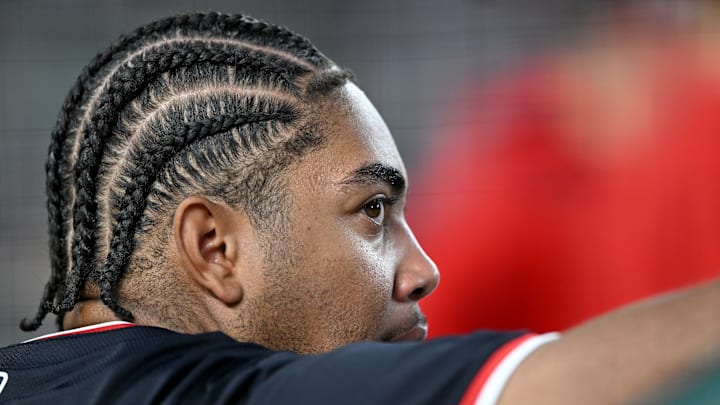Pyrite, often referred to as "fool's gold" for its appearance, is a mineral that gives off an odor similar to that of rotten eggs when scraped against a hard surface, revealing its true identity. I don't mean to imply that Kyle Finnegan has a severe B.O. issue, but there's something under the hood that, so far, doesn't smell very good.
Finny's been excellent to start this season, for sure. His 1.64 ERA and 8-1 shutdown ratio have saved the Nationals on multiple occasions en route to the team's 12-15 start. So far, though, there's no real evidence I've seen that this can continue. He's yet to give up a home run, which, for a 33-year-old with a fastball that's lost a full tick of velocity, isn't sustainable at even a similarly low level. Finnegan averages home runs on 15% of his allowed fly balls across his career, so even with a heightened ground ball rate so far this year, these numbers have to normalize soon. Obviously, the Nationals don't really need Finnegan to become a lockdown closer, and his xFIP (which takes FIP and normalizes all fly ball totals to the league average HR/FB rate) is still only 3.20, but don't expect quite this level of effectiveness all season.
Another guy I really can't buy into is Mitchell Parker right now. Parker has likely thrilled his fantasy owners and Nationals fans alike by running a 1.39 ERA through his first five starts of 2025, posting quality starts in four of the five. Once again, though, it comes back to the home run/fly ball ratio. Historically in the minor leagues, Parker has never been a ground ball arm, and he throws his 93 MPH four-seam fastball about half the time. That four-seamer with above-average ride coming from an over-the-top arm slot has been an effective weapon, but batters are eventually going to start getting balls over the fence and doing damage against it, and his splitter, which got manhandled last year and hasn't improved much this year, is going to be exposed again as a result. Parker certainly has the capability to be an effective 4 or 5 slot guy, but with a 2.7% HR/FB ratio and .191 BABIP against, I don't expect him to pitch like an ace much longer.
Someone I do feel better about is MacKenzie Gore. It's not a particularly controversial take to say that MacKenzie Gore is a good pitcher now, but after years of Nationals fans playing a "will he, won't he" with Gore's prospective breakout, he's put up two outings of 13 strikeouts each with no real signs of slowing down. Gore continues to evolve as a pitcher, slashing his cutter usage in favor of a more refined slider which he's using as an out pitch more often. Realistically, one would probably like to see more weak contact or more spin on his main secondary, the curve, but his locations and sequencing have been such that he's struck out over 37% of the batters he's faced. Across 35 innings and nearly 600 pitches, Eno Sarris and Max Bay's Pitching+ model is fond of all of his top three pitches, and Cameron Grove's PitchingBot grades his fastball as his most prodigious offering, giving it a 63/80 overall.
The last name I want to touch on is James Wood. The summer of James Wood may well soon be upon us. The big guy cut his hair and is experiencing perhaps a reverse Samson effect, hitting the cover off the ball to the tune of 8 home runs and a .904 OPS. What's terrifying is that he's actually underperforming (.545) his expected slugging value (.600), sitting 12 points under his expected wOBA. His walk rate has continued to rise, and he's made it very clear that he absolutely does not need to pull the ball to hit home runs on a regular basis with his enormous 6'7" frame and freakish athleticism. James Wood is off to a hot start, but maybe more importantly, there's very good odds he only continues to get better.
